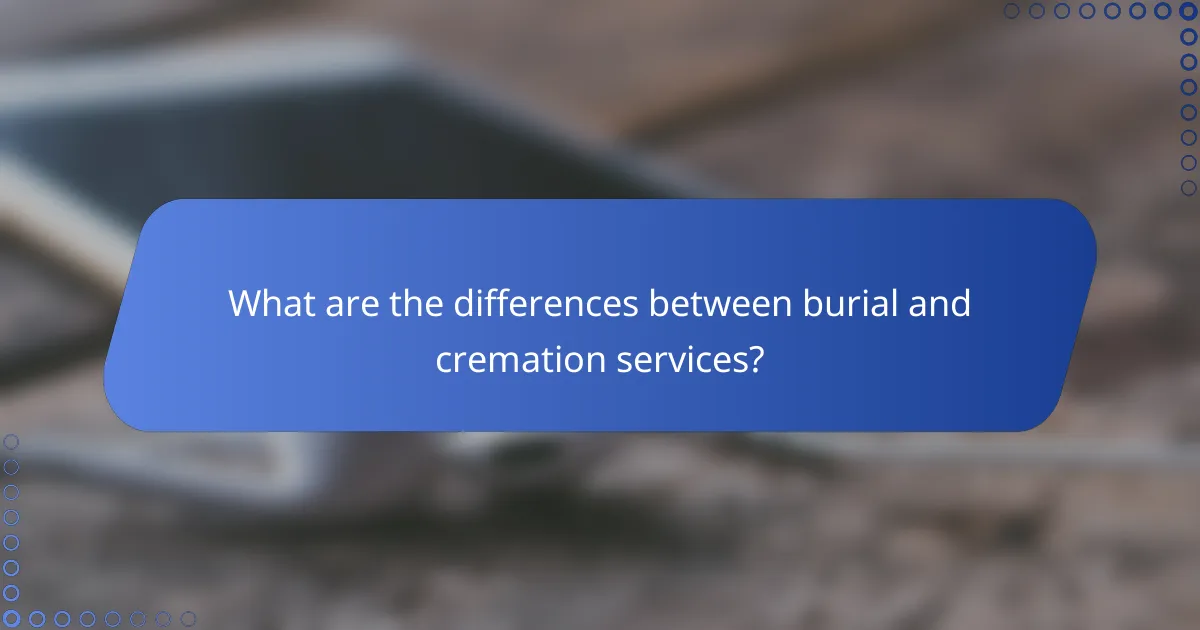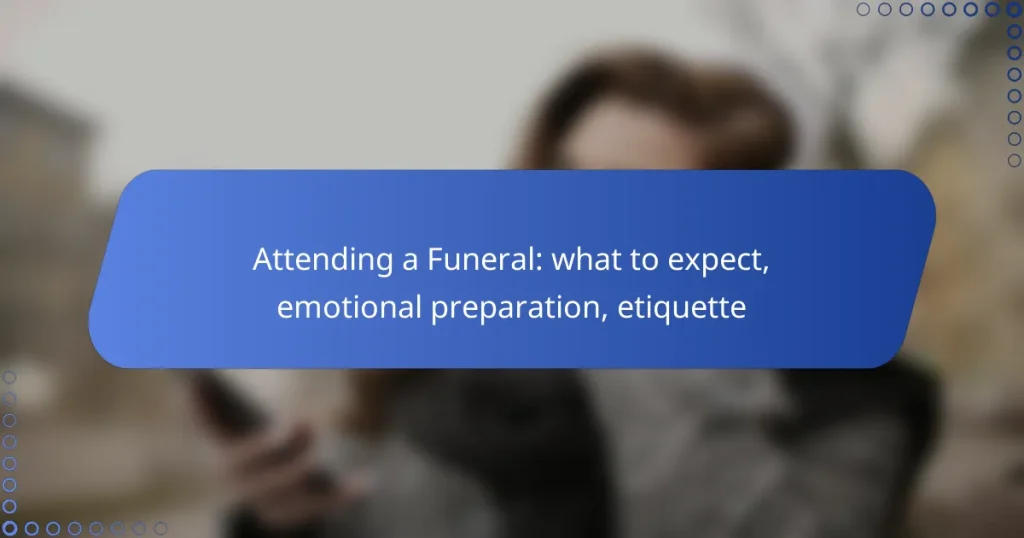Attending a funeral is a significant event that requires sensitivity and respect, as it serves to honor the deceased and support their loved ones. Being emotionally prepared for the range of feelings that may arise can help you navigate this challenging experience. Additionally, understanding proper etiquette, such as appropriate dress and behavior, is essential to show your respect for the grieving family.

What should I expect when attending a funeral in Canada?
Attending a funeral in Canada typically involves a blend of solemnity and respect, with specific customs that may vary by region and cultural background. Expect to participate in rituals that honor the deceased while providing support to their family and friends.
Traditional funeral practices
Traditional funeral practices in Canada often include a viewing or wake, followed by a formal service at a funeral home or place of worship. Many families choose to have a burial or cremation, with the service reflecting the deceased’s beliefs and values.
In some communities, specific cultural customs may be observed, such as Indigenous ceremonies or religious rites. These practices can significantly influence the structure and tone of the funeral service.
Common rituals and ceremonies
Common rituals at Canadian funerals include readings from religious texts, eulogies, and moments of silence. Attendees may also participate in singing hymns or sharing personal memories of the deceased.
Some families may incorporate unique elements, such as a memory table displaying photographs or personal items, allowing guests to reflect on the life of the individual who has passed.
Emotional atmosphere
The emotional atmosphere at a funeral in Canada is generally somber, with attendees expressing grief and support for one another. It is common to see tears, but also moments of laughter as people share fond memories of the deceased.
Understanding that everyone processes grief differently can help you navigate the emotional landscape. Be prepared to offer comfort and listen to others, as this can be a healing experience for all involved.
Duration and schedule
Funeral services in Canada typically last between one to two hours, though the entire event, including visitations and receptions, may span several hours or even days. Check the schedule provided by the family or funeral home for specific timings.
Arriving on time is crucial, as many services begin promptly. If there is a reception afterward, it is often customary to attend and offer condolences to the family.
Location types
Funerals in Canada can take place in various locations, including funeral homes, places of worship, or even outdoor settings. The choice of location often reflects the deceased’s preferences and cultural background.
Funeral homes are the most common venues, providing a respectful environment for services. However, some families may opt for a more personal setting, such as a backyard or community center, to celebrate the life of their loved one.

How can I emotionally prepare for a funeral?
Emotionally preparing for a funeral involves acknowledging your feelings and understanding the grieving process. Anticipating a range of emotions can help you cope better during this challenging time.
Understanding grief stages
Grief typically unfolds in stages, including denial, anger, bargaining, depression, and acceptance. These stages are not linear; you may experience them in different orders or revisit some stages multiple times. Recognizing these stages can help you understand your emotional responses and those of others attending the funeral.
Each person’s experience with grief is unique, influenced by their relationship with the deceased and personal coping mechanisms. Be patient with yourself and others as you navigate these emotions together.
Self-care strategies
Prioritizing self-care during this time is crucial. Engage in activities that promote relaxation and well-being, such as taking walks, practicing mindfulness, or journaling your thoughts. These practices can help you process your emotions and reduce stress.
Maintain a healthy routine by eating balanced meals and getting adequate sleep. Avoid excessive alcohol or caffeine, as these can heighten anxiety and emotional distress.
Seeking support from friends
Reaching out to friends and family can provide essential emotional support. Share your feelings and memories of the deceased with those who understand your loss. This connection can foster a sense of community and help alleviate feelings of isolation.
Consider organizing a small gathering with close friends to share stories and support one another. This can create a safe space for expressing grief and honoring the memory of the loved one.

What is the proper etiquette for attending a funeral?
Proper etiquette for attending a funeral involves showing respect and support for the grieving family. This includes adhering to dress codes, demonstrating appropriate behavior, expressing condolences, and understanding gift-giving practices.
Dress code guidelines
When attending a funeral, it is customary to wear somber, conservative clothing. Dark colors such as black, navy, or gray are typically preferred, as they convey respect for the deceased and their family.
Avoid overly casual attire like jeans or bright colors. For men, a suit or dress shirt with slacks is appropriate, while women may opt for a dress or blouse with a skirt or dress pants.
Behavioral expectations
During a funeral, maintain a respectful demeanor. This includes speaking softly, refraining from laughter, and being mindful of your phone usage—keeping it silent or off is advisable.
Offer support to the family by listening attentively and providing comfort. Avoid discussing unrelated topics or making the event about yourself.
Condolence expressions
Expressing condolences is a vital part of funeral etiquette. A simple “I’m sorry for your loss” or “My thoughts are with you” can be comforting to grieving individuals.
Consider writing a heartfelt note or card if you are unable to speak with the family directly. Personal anecdotes about the deceased can also be meaningful when shared appropriately.
Gift-giving practices
Gift-giving at funerals can vary by culture and personal preference. Common practices include sending flowers, making a donation to a charity in the deceased’s name, or providing food for the family.
When in doubt, consider asking a close family member about their preferences. If you choose to give flowers, ensure they are appropriate for the occasion, and avoid overly extravagant arrangements.

What are the differences between burial and cremation services?
Burial and cremation services are two primary options for handling remains after death, each with distinct processes and considerations. Burial involves interring the body in the ground, while cremation reduces the body to ashes through intense heat.
Burial service details
A burial service typically includes a viewing or wake, a funeral ceremony, and the interment of the body in a cemetery plot. Families often choose to include personalized elements such as music, readings, or eulogies to honor the deceased.
Burial requires purchasing a casket and a burial plot, and it may involve additional costs for grave markers or memorial services. Regulations regarding burial practices can vary by location, so it’s essential to check local laws and cemetery requirements.
Cremation service details
Cremation services usually involve a memorial service, which can take place before or after the cremation. Families may choose to keep the ashes in an urn, scatter them in a meaningful location, or incorporate them into memorial items.
Unlike burial, cremation does not require a casket, although a simple container for the body is necessary. Many funeral homes offer various options for urns and memorial services, allowing for personalization based on the family’s wishes.
Costs associated with each option
The costs of burial services can range significantly, often from several thousand to over ten thousand USD, depending on factors like the casket, burial plot, and service fees. Additional expenses may include headstones and ongoing maintenance of the grave site.
Cremation services are generally less expensive, with costs typically ranging from a few hundred to a few thousand USD. This option can be more budget-friendly, especially when opting for direct cremation without a formal service.

How can I support grieving family members?
Supporting grieving family members involves offering practical assistance, being present for emotional support, and expressing your condolences thoughtfully. Each of these actions can help ease their burden during a difficult time.
Offering practical help
Practical help can be invaluable to grieving families. This might include preparing meals, running errands, or assisting with household chores. Offering specific tasks rather than a general “let me know if you need anything” can make it easier for them to accept help.
Consider organizing a meal train with friends or family to ensure they have nutritious meals during the initial days of mourning. Simple acts like grocery shopping or helping with childcare can also provide significant relief.
Listening and providing companionship
Being a good listener is crucial when supporting someone who is grieving. Allow them to express their feelings without interruption, and validate their emotions. Sometimes, just being present and sharing silence can be comforting.
Encourage them to share memories of the deceased, which can help them process their grief. Regular check-ins, whether through phone calls or visits, can also remind them that they are not alone during this challenging time.
Sending sympathy cards
Sending a sympathy card is a thoughtful way to express your condolences. Choose a card that reflects your relationship with the bereaved and includes a personal message. A few heartfelt sentences can mean a lot during this time.
Consider including a small gesture, such as a gift card for a local restaurant or a donation to a charity in memory of the deceased. This can provide additional support and show that you care beyond just words.


